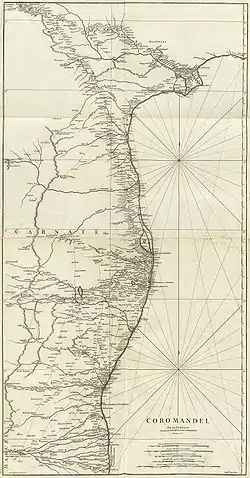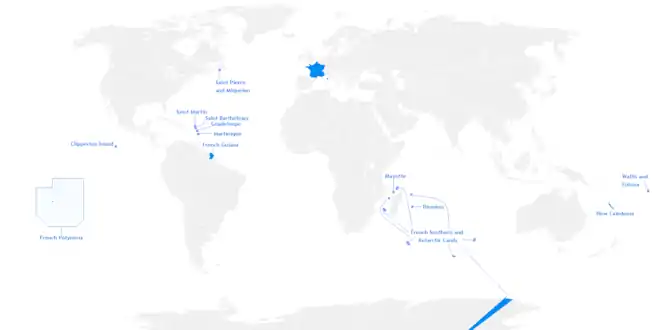Coromandel Coast
The Coromandel Coast is the southeastern coast region of the Indian subcontinent, bounded by the Utkal Plains to the north, the Bay of Bengal to the east, the Kaveri delta to the south, and the Eastern Ghats to the west, extending over an area of about 22,800 square kilometres.[1] Its definition can also include the northwestern coast of the island of Sri Lanka. The coast has an average elevation of 80 metres and is backed by the Eastern Ghats, a chain of low, flat-topped hills.


Etymology
Coromondel is the Dutch pronunciation of "Karimanal", a village in the Sriharikota island in the north of Pazhavercadu (Pulecat Lake).[2] An Italian explorer Ludovico di Varthema perhaps first gave the name Coromandel in 1510, which was then used on maps by the Portuguese, but it was the Dutch who took up serious trading there.[3] Pazhavercadu (Pulicat) was an early Dutch settlement along with Masoolipatnam in present-day Andhra Pradesh. There is a Dutch cemetery belonging to the 17th century at Pulicat. It is said that the first Dutch ship stopped here for fresh drinking water, and upon asking the name of the place Karimanal was spelled as Coromondal (K replaced with C and d inserted).
The land of the Chola dynasty was called Cholamandalam (சோழ மண்டலம்) in Tamil, translated as The realm of the Cholas, from which the Portuguese derived the name Coromandel.[4][5][6][7][8] The name could also be derived from Karai mandalam, meaning The realm of the Shores.[9]
Description
Economy
Agriculture is the mainstay of the coastal economy. Rice, pulses (legumes), sugarcane, cotton, and peanuts (groundnuts) are grown. Bananas and betel nuts are grown together with rice in the low-rainfall region of the interior. There are casuarina and coconut plantations along the coast.
Large-scale industries produce fertilizers, chemicals, film projectors, amplifiers, trucks, and automobiles. There is a heavy vehicle and armoured car factory at Avadi and a nuclear power station at Kalpakkam.
Roads and railways linking Chennai, Cuddalore, Chidambaram, Chengalpattu, and Puducherry run parallel to the coast.
Geography
The coast is generally low, and punctuated by the deltas of several large rivers, including the Kaveri, Palar, Penner, and Krishna River, which rise in the highlands of the Western Ghats and flow across the Deccan Plateau to drain into the Bay of Bengal. The alluvial plains created by these rivers are fertile and favour agriculture. The rivers remain dry during most of the year. There is little forest cover, but marshes, swamps, scrub woodlands, and thorny thickets are common.
The coastline forms a part of Tamil Nadu and Andhra Pradesh. The important ports include Chennai, Thoothukkudi, Nellore, Ennore and Nagapattinam, which take advantage of their close proximity with regions rich in natural and mineral resources and good transport infrastructure.
Climate
The Coromonnel Coast falls in the rain shadow of the Western Ghats mountain range, and receives less rainfall during the summer southwest monsoons, which contributes heavy rainfall in some parts of India. The region averages 800 mm/year, most of which falls between October and December. The topography of the Bay of Bengal, and the staggered weather pattern prevalent during the season favours northeast monsoons, which have a tendency to cause cyclones and hurricanes rather than a steady precipitation. As a result, the coast is hit by inclement weather almost every year between October and January.
The high variability of rainfall patterns is also responsible for water scarcity and famine in most areas not served by the great rivers. For example, the city of Chennai is one of the driest cities in the country in terms of potable water availability, despite high percentage of moisture in the air, due to the unpredictable, seasonal nature of the monsoon.
Flora
The Coromandel Coast is home to the East Deccan dry evergreen forests ecoregion, which runs in a narrow strip along the coast. Unlike most of the other tropical dry forest Biome regions of India, where the trees lose their leaves during the dry season, the East Deccan dry evergreen forests retain their leathery leaves year round.
The Coromandel Coast is also home to extensive mangrove forests along the low-lying coast and river deltas, and several important wetlands, notably Kaliveli Lake and Pulicat Lake, that provide habitat to thousands of migrating and resident birds.
History

By late 1530 the Coromandel Coast was home to three Portuguese settlements at Nagapattinam, São Tomé de Meliapore, and Pulicat . In the 17th and 18th centuries, the Coromandel Coast was the scene of rivalries among European powers for control of the India trade. The British established themselves at Fort St George (Madras) and Masulipatnam, the Dutch at Pulicat, Sadras and Covelong, the French at Pondicherry, Karaikal and Nizampatnam, the Danish in Dansborg at Tharangambadi.
The Coromandel Coast supplied Indian Muslim eunuchs to the Thai palace and court of Siam (modern Thailand).[10][11] The Thai at times asked eunuchs from China to visit the court in Thailand and advise them on court ritual since they held them in high regard.[12][13]
Eventually the British won out, although France retained the tiny enclaves of Pondichéry and Karaikal until 1954. Chinese lacquer goods, including boxes, screens, and chests, became known as "Coromandel" goods in the 18th century, because many Chinese exports were consolidated at the Coromandel ports.
Two of the famous books on the economic history of the Coromandel Coast are Merchants, companies, and commerce on the Coromandel Coast, 1650–1740 (Arasaratnam, Oxford University Press, 1986) and The World of the Weaver in Northern Coromandel, c.1750-c.1850 (P. Swarnalatha, Orient Longman, 2005).
On 26 December 2004, one of the deadliest natural disasters in modern history, the Indian Ocean earthquake, struck off the western coast of Sumatra (Indonesia). The earthquake and subsequent tsunami reportedly killed over 220,000 people around the rim of the Indian Ocean. The tsunami devastated the Coromandel Coast, killing many and sweeping away many coastal communities.
Applications of the name
Four ships of the Royal Navy have borne the name HMS Coromandel after the Indian coast. The Coromandel Peninsula in New Zealand was named after one of these ships, and the town of Coromandel, New Zealand was named after the peninsula. Coromandel Valley, South Australia, and its neighbouring suburb, Coromandel East, gain their name from the ship Coromandel, which arrived in Holdfast Bay from London in 1837 with 156 English settlers. After the ship reached the shore, some of its sailors deserted, intending to remain behind in South Australia, and took refuge in the hills in the Coromandel Valley region.
In Slovene the idiom Indija Koromandija (India Coromandel) means a land of plenty,[14] a promised land, a utopia where "Houses are bleached with cheese and covered with cake".[15]
References
- Encyclopædia Britannica entry on Coromandel Coast
- Topographic Map of India "66C/7 & 66C/11" by Survey of India
- Allen, Charles (13 December 2017). "How A Coast Got Its Name". Books. The Hindu. Retrieved 24 December 2020.
- The Land of the Tamulians and Its Missions, by Eduard Raimund Baierlein, James Dunning Baker
- South Indian Coins – Page 61 by T. Desikachari – Coins, Indic – 1984
- Indian History – Page 112
- Annals of Oriental Research – Page 1 by University of Madras – 1960
- The Periplus of the Erythræan Sea by Wilfred Harvey Schoff
- Edgar Thurston (2011). The Madras Presidency with Mysore, Coorg and the Associated States. Cambridge University Press. p. 11. ISBN 978-1-107-60068-3.
- Peletz (2009), p. 73 Gender Pluralism: Southeast Asia Since Early Modern Times, p. 73, at Google Books
- Peletz (2009), p. 73 Gender Pluralism: Southeast Asia Since Early Modern Times, p. 73, at Google Books
- Peletz (2009), p. 75 Gender Pluralism: Southeast Asia Since Early Modern Times, p. 75, at Google Books
- Peletz (2009), p. 75 Gender Pluralism: Southeast Asia Since Early Modern Times, p. 75, at Google Books
- "Indija Koromandija". Slovar slovenskega knjižnega jezika [Dictionary of Slovenian Literary Language] (in Slovenian). Retrieved 24 December 2020.
According to popular belief, a land where everything is enough, where it is very good: their grandmother told them about India Coromandel / expressing all of her India Coromandel collapsed imaginary, expected happiness
- "Razvezani jezik - Indija koromandija". Free dictionary of living Slovene (in Slovenian). Retrieved 24 December 2020.
A folk song sings: India Koromandija! /They cook the porridge in a spoon, /the house are bleached with cheese,/ cover them with cake,/ and curd them with cottage cheese. It also houses the first Slovene anti-utopia, created by Anton Mahnič in In 1884 he published in Slovene, a political newspaper for the Slovene nation.
Further reading
"India". World Statesman. Retrieved 24 December 2020. Search for Dutch India and French India for information on Coromandel coast
External links
| Wikimedia Commons has media related to Coromandel Coast. |
.svg.png.webp)
